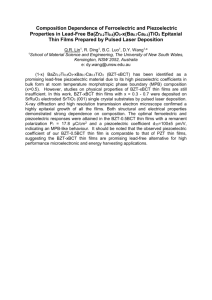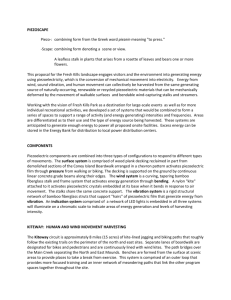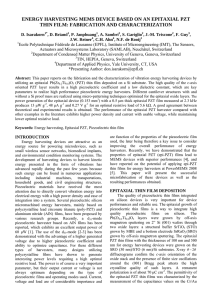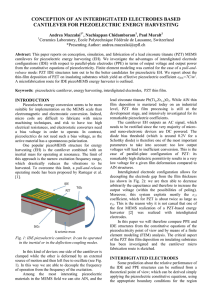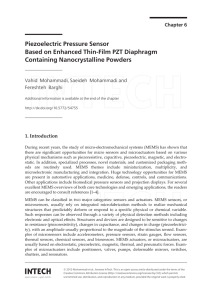VIBRATION ENERGY HARVESTING WITH PZT THIN FILM MICRO DEVICE
advertisement
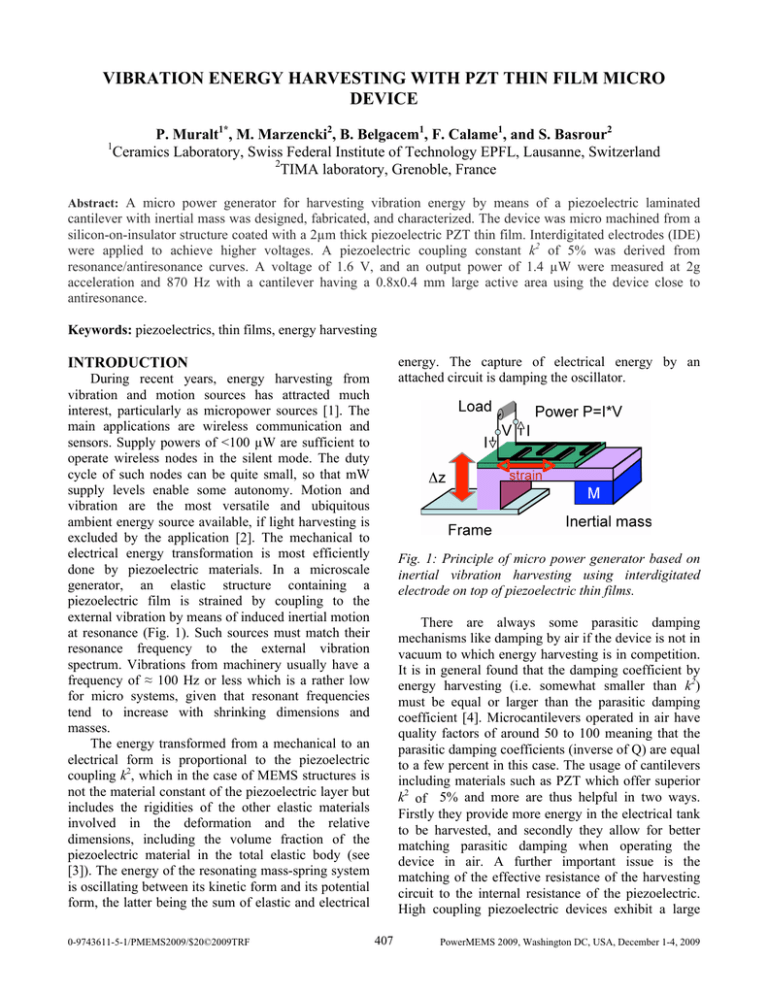
VIBRATION ENERGY HARVESTING WITH PZT THIN FILM MICRO
DEVICE
1
P. Muralt1*, M. Marzencki2, B. Belgacem1, F. Calame1, and S. Basrour2
Ceramics Laboratory, Swiss Federal Institute of Technology EPFL, Lausanne, Switzerland
2
TIMA laboratory, Grenoble, France
Abstract: A micro power generator for harvesting vibration energy by means of a piezoelectric laminated
cantilever with inertial mass was designed, fabricated, and characterized. The device was micro machined from a
silicon-on-insulator structure coated with a 2µm thick piezoelectric PZT thin film. Interdigitated electrodes (IDE)
were applied to achieve higher voltages. A piezoelectric coupling constant k2 of 5% was derived from
resonance/antiresonance curves. A voltage of 1.6 V, and an output power of 1.4 µW were measured at 2g
acceleration and 870 Hz with a cantilever having a 0.8x0.4 mm large active area using the device close to
antiresonance.
Keywords: piezoelectrics, thin films, energy harvesting
energy. The capture of electrical energy by an
attached circuit is damping the oscillator.
INTRODUCTION
During recent years, energy harvesting from
vibration and motion sources has attracted much
interest, particularly as micropower sources [1]. The
main applications are wireless communication and
sensors. Supply powers of <100 µW are sufficient to
operate wireless nodes in the silent mode. The duty
cycle of such nodes can be quite small, so that mW
supply levels enable some autonomy. Motion and
vibration are the most versatile and ubiquitous
ambient energy source available, if light harvesting is
excluded by the application [2]. The mechanical to
electrical energy transformation is most efficiently
done by piezoelectric materials. In a microscale
generator, an elastic structure containing a
piezoelectric film is strained by coupling to the
external vibration by means of induced inertial motion
at resonance (Fig. 1). Such sources must match their
resonance frequency to the external vibration
spectrum. Vibrations from machinery usually have a
frequency of ≈ 100 Hz or less which is a rather low
for micro systems, given that resonant frequencies
tend to increase with shrinking dimensions and
masses.
The energy transformed from a mechanical to an
electrical form is proportional to the piezoelectric
coupling k2, which in the case of MEMS structures is
not the material constant of the piezoelectric layer but
includes the rigidities of the other elastic materials
involved in the deformation and the relative
dimensions, including the volume fraction of the
piezoelectric material in the total elastic body (see
[3]). The energy of the resonating mass-spring system
is oscillating between its kinetic form and its potential
form, the latter being the sum of elastic and electrical
0-9743611-5-1/PMEMS2009/$20©2009TRF
Fig. 1: Principle of micro power generator based on
inertial vibration harvesting using interdigitated
electrode on top of piezoelectric thin films.
There are always some parasitic damping
mechanisms like damping by air if the device is not in
vacuum to which energy harvesting is in competition.
It is in general found that the damping coefficient by
energy harvesting (i.e. somewhat smaller than k2)
must be equal or larger than the parasitic damping
coefficient [4]. Microcantilevers operated in air have
quality factors of around 50 to 100 meaning that the
parasitic damping coefficients (inverse of Q) are equal
to a few percent in this case. The usage of cantilevers
including materials such as PZT which offer superior
k2 of 5% and more are thus helpful in two ways.
Firstly they provide more energy in the electrical tank
to be harvested, and secondly they allow for better
matching parasitic damping when operating the
device in air. A further important issue is the
matching of the effective resistance of the harvesting
circuit to the internal resistance of the piezoelectric.
High coupling piezoelectric devices exhibit a large
407
PowerMEMS 2009, Washington DC, USA, December 1-4, 2009
frequency gap between the resonance frequency
where the internal resistance is lowest and currents are
highest, and the antiresonance frequency where the
internal resistance and the voltages are highest. The
optimal working point is not necessarily the resonance
as often assumed. An important point in thin-film
piezoelectric harvesters is the choice of the electrodes.
PZT parallel-plate capacitors exhibit a large
capacitance, resulting in low voltage outputs. One has
to keep in mind that vibration harvesting devices have
an ac current output that needs to be rectified for
energy storage in a battery. All such rectifying
semiconductor devices need at least 500 mV for
efficient rectification [5], even when using charge
transfer switches for voltage multiplication. As a
consequence, it is much better to use interdigitated
electrodes for harvesting with high permittivity
piezoelectrics. Such devices were first demonstrated
by Kim and coworkers [6]. This paper reports on a
micro device according to Fig. 1 based on PZT thin
films and SOI substrates, with the goal to achieve a
large piezoelectric coupling factor, and an exploitable
range of voltage and power output.
Finally the cantilevers were released by deep silicon
etching (Bosch process) leaving a piece of the handle
wafer with full thickness at the end of the cantilever.
This piece serves as inertial mass, following and idea
demonstrated for accelerometers [11].
Fig. 3: SEM image of the front side after PZT
deposition, etching of the barrier oxide layer and the
device silicon layer.
ELECTRICAL CHARACTERIZATION
The fabricated devices were tested on a controlled
vibration source – a DataPhysics V20 shaker
controlled by a custom LabVIEW application. The
same application provided a closed loop acceleration
amplitude control and data acquisition through a
National Instruments card PCI-6024E. For each
measure a variable load was connected between the
electrodes of the generator and the output voltage was
observed through INA116 (BurrBrown) high
impedance instrumentation amplifier. The output
power was calculated from the RMS value of the
voltage measured and the resistive load value. The
output power was measured as a function of
frequency and load resistance. The fundamental
resonance was observed at around 870 Hz (Fig. 4). At
small load the power output peaks at the resonance
frequency, at large load the power peaks close to the
antiresonance frequency. The electromechanical
coupling coefficient can be derived from the
frequency separation of the two peaks:
Fig. 2: Scanning Electron Microsope (SEM) image of
the interdigitated electrode.
FABRICATION
The chosen design is based on a Silicon On
Insulator (SOI) wafer with a 5µm thick device layer.
The device layer supplies the elastic layer for the
piezoelectric bending transducer and spring. First, a
1µm wet oxide layer was grown on the 100 mm SOI
wafer. This layer is at the same time barrier layer
against Si-PZT interdiffusion and stress compensation
layer [7]. To avoid Pb diffuse into SiO2, a 10-20 nm
thick TiO2 layer was deposited prior to grow the 2µm
thick PbZr0.53Ti0.47O3 (PZT) film by sol gel techniques
[8, 9]. A platinum top electrode was sputter deposited
and dry etched (Fig. 2). PZT was etched in a HCl:HF
acid (details see [10]). The barrier SiO2 layer and the
Si device layer were patterned by dry etching (Fig. 3).
k2 ≈
2( f a − f r )
fr
(1)
The curves of fig. 4 yield a value of k2 = 5 %. This
is a quite reasonable value and equals about the values
obtained in piezoelectric micromachined transducers,
using, however, PZT on Pt bottom electrodes [12].
408
than earlier versions [6], a further decrease is
desirable in order to exploit more frequent vibrations
below 100 Hz. A heavier mass would also contribute
to achieve such a goal. In addition, the silicon layer
could be thinned down. The large coupling constant k2
of 5 % means that we can well use such a transducer
for operation in air where damping coefficients of a
few percent may occur.
CONLCUSION
A well functioning piezoelectric energy
harvesting device was obtained based on PZT thin
films deposited by sol-gel techniques. A high
piezoelectric coupling could be demonstrated. Voltage
and power level are in a good range for potential
exploitation.
Fig. 4: Output power as a function of frequency and
load resistor.
Acknowledgements
This work was supported by the European project
VIBES.
A optimal power output was observed at
antiresonance, on an optimal load of 2MW in order to
obtain high output voltages. The output power,
presented in Fig. 5 is equal to 1.4 µW for 2g
acceleration, the voltage reaching 1.6 V.
REFERENCES
[1] Choi WJ, Jeon Y, Jeong J-h, Sood R, and Kim S-G
2006 Energy harvesting MEMS device based on thin
film piezoelectric cantilevers J. Electroceramics 17
543-548
[2] Mitcheson PD, Yeatman EM, Rao GK, Holmes AS,
and Green TC 2008 Energy harvesting from human
and machine motion for wireless electronic devices
Proceedings of the IEEE 96 1457-86
[3] Muralt P 1997 Piezoelectric thin films for MEMS
Integrated Ferroelectrics 17 297-307
[4] Mitcheson PD, Reilly EK, Toh T, Wright PK, and
Yeatman EM 2007 Performance limits of three MEMS
inertial energy generator transduction types J.
Micromech. Microeng. 17 S211-S216
[5] Torah R, Glynne-Jones P, Tudor M, O'Donnell T, Roy
S, and Beeby S 2008 Self-powered autonomous
wireless sensor node using vibration energy harvesting
Meas.Sci.Technol. 19 125202
[6] Jeon YB, Sood R, Jeong J-h, and Kim S-G 2005
MEMS power generator with transverse mode thin film
PZT Sensors and Actuators A 122 16-22
[7] Ledermann N, Muralt P, Baborowski J, Forster M, and
Pellaux J-P 2004 Piezoelectric PZT thin film cantilever
and bridge acoustic sensors for miniaturized
photoacoustic gas detector J.Micromech.Microeng. 14
1650-1658
[8] Belgacem B, Calame F, and Muralt P 2007
Piezoelectric ultrasonic transducers with thick PZT solgel films J. Electroceramics 19 311-314
[9] Calame F and Muralt P 2007 Growth and properties of
gradient free sol-gel lead zirconate titanate thin films
Appl.Phys.Lett. 90 062907
[10] Ledermann N, Muralt P, Baborowski J, et al. 2003
{100}-textured, piezoelectric Pb(Zrx, Ti1-x)O3 thin
films for MEMS: integration, deposition and properties.
Fig. 5: Voltage and output power as a function of
acceleration.
DISCUSSION
The obtained powers are in the expected range. A
high enough voltage was achieved thanks to
interdigitated electrodes and harvesting close to the
antiresonance frequency. The minimal acceleration to
arrive at the required 0.5 V amounts to about 0. 4g.
The active transducer area amounts to 0.4x0.8 mm,
thus delivering a power density of 160 µW/cm2/g. In
the present design the inertial mass is too large,
covering about 2/3 of the area. Future developments
must include masses of higher density. Although our
micro harvester operates at much lower frequencies
409
Sensors and Actuators A 2003 105 162-170
[11] Baborowski J, Hediger S, Muralt P, and Wüthrich C
1999 Micromachined fabrication and characterization
of accelorometers based on PZT thin films.
Ferroelectrics 224 283-290.
[12] Muralt P, Ledermann N, Baborowski J, et al. 2005
Piezoelectric Micromachined Ultrasonic Transducers
Based on PZT Thin Films. IEEE Trans. UFFC 2005 52
2276-88.
410



